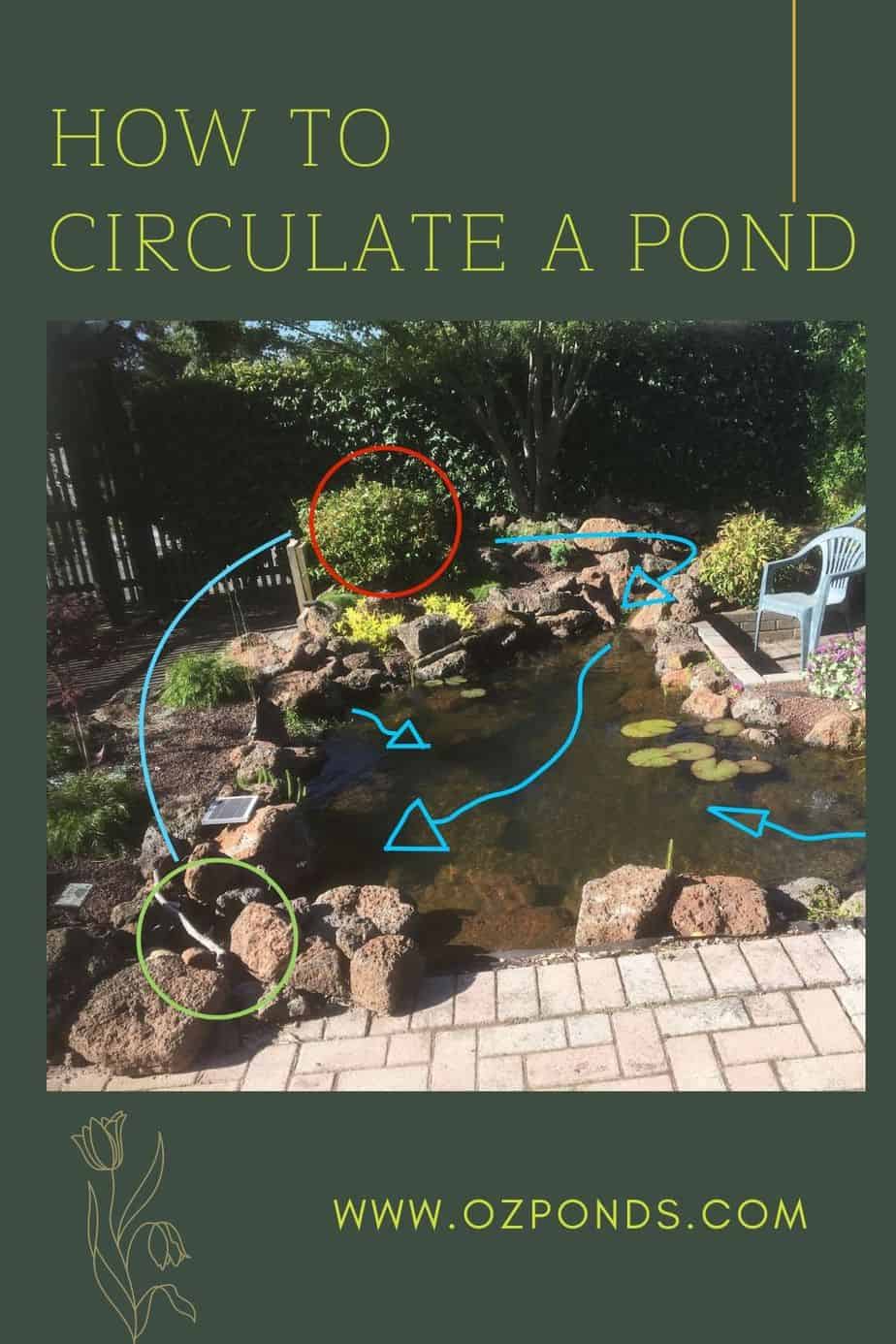How you circulate your pond water can make a huge difference in how clean and healthy your pond water is.
Here are some of the best ways to improve pond circulation:
- Position the pump to maximise circulation.
- Moving water through or over surfaces that contain beneficial bacteria’s and organisms.
- Using the pull of the pump to capture and remove floating debris before it sinks.
- Providing plenty of oxygen and water agitation.
- Placing equipment where it can easily be accessed for cleaning and maintenance.
Maximise circulation
Water circulation is a very important to your ponds health. Most pond experts will recommend that the water in a pond should be circulated at least once every hour.
Where you position your pond pump will impact on how much water is circulated.
Best practice is to place the pump in an area of the pond furthest from the point of entry.
The point of entry should be after the water has been filtered (we will get to that in a moment).
In essence dirty water is being removed by the pump and clean water returned.
An example of poor circulation is if you positioned the pump just below point of entry, only a small amount of the overall pond water volume is being circulated.
The area of the pond with no circulation becomes stagnant and much more unhealthy!
If using waterfalls and streams you should always position the pump or pumps away from these areas to increase the overall water circulation!
In large or irregular shaped ponds the use of jets (Amazon link) can be incredibly effective at propelling water into the desired areas.
Lately I have been using solar powered pumps to circulated water in these dead or stagnant zones.
Pulling water
Using your pond pump to pull water and debris into a designated area will make maintenance so much easier.
So many people place their pond pumps on the bottom of the pond. Your pump can be used so much more effectively if it is placed inside a skimmer box (amazon link) or intake bay.
Both work by pulling the water into a small area, this creates tension or a current along the water surface. This pulls any floating debris into the skimmer or intake bay where it can be easily removed.
Removing floating material before it sinks has numerous benefits:
- Reduces or even eliminates the need for expensive or time consuming mass clean outs.
- Provides valuable mechanical filtration right there in the pond. No need for large external filters.
- Reduces the load on the biological filter (beneficial bacterias).
- Will extend the life of the pump. It’s not sucking up all that solid gunk at the bottom of the pond.
It is crazy not to incorporate one or the other in any pond design. You are already paying to run the pump, this way you reduce maintenance, add extra filtration and extend other life of your pond pump all in one hit.
Infusing oxygen
When talking about pond circulation it would be remiss if i didn’t mention oxygen. Providing plenty of oxygenated water will keep the beneficial bacteria, micro organisms, fish and plants happy and healthy.
Adding oxygen doesn’t need to be hard or expensive. One of the simplest way to enhance the oxygen levels of your pond is to add a waterfall.
As the waterfall splashes into the pond it agitates the water allowing it to be infused with the surrounding air.
Again this is an effective way of further utilising your pond pump. There are plenty of waterfall spillways (Amazon link) available for purchase, some will include built in filters.
Another cost effective way to improve circulation and increase oxygen within the pond is the use of an aerator (Amazon link). These offer great bang for your buck!
Oxygen is incredibly valuable during warm weather. As the water heats up it loses oxygen. Always consider how you can add oxygen when designing how your pond will be circulated.
Bacteria and filtration
Beneficial bacteria is the ultimate pond cleaner! Positioning our pond pump to maximise the work these tiny organisms do is a must!
If you’re unsure about the role beneficial bacteria play in maintaining a healthy pond please read this article on beneficial bacteria and the nitrogen cycle.
The more contact the pond water has with beneficial bacteria’s the better!
So we can use our pond circulation to either draw water through surfaces that have plenty of bacteria. Or use the pump to pump water up, through, and over areas with plenty of bacteria.
Adding a bog or wetland filter to your pond is the best biological filtration in my opinion. Click the link to read my article.
For an example of a small pond with the pump positioned in the middle and it’s running a simple fountain. We can easily place the pump in a pot, container or crate and surround it with lava rock, bio balls or ceramic noodles.
All 3 have big surface areas in a small package, which is perfect for beneficial bacteria to colonise. As the water is sucked into the pond pump the water is pulled through the beneficial bacteria.
Incorporating a gravel bottom and rock walls will also add huge amounts of surface area. Natural is my personal preference but some people prefer a more formal look.
Utilising a pond pump with built in filter media will help provide the ideal home for beneficial bacteria. Just keep in mind these will require regular maintenance.
It’s even easier in larger water features that have waterfalls and streams. A stream acts as one big filter! Provided it’s got plenty of rocks and plant roots where beneficial bacteria will live and thrive.
As the water moves along the stream the bacteria will do its thing!
A waterfall can act in a similar way, however the water is generally moving much to fast for the bacteria to be super effective. What we can do is use a waterfall filter, these can be brought or diy’d.
A waterfall filter will slow the water as it fills up before spilling out to create the waterfall. Within the chamber where the water is moving slower we can put in our filter media like bio balls, ceramic noodles, lava rock and even coarse sponges. The bacteria will colonise these, and as the water passes through its being purified.
For me the ultimate biological filtration unit is a bog or wetland filter. These can be as large or small as needed. They provide an abundant habitat for bacteria and organisms to purify the water. To read more about wetland and bog filters click here to read our more in-depth article.
Easy access
If it’s difficult to access a pond pump, filter, jet, skimmer or intake bay you are more inclined to neglect checking on the equipment. Of course we want to hide these pieces of equipment so that our ponds look as natural as possible.
Just be mindful to place these items in areas where you can easily access them all year round. I like to position skimmers or intake bays in areas that I use naturally to approach the pond.
These areas are free of obstructions eg. large plants or against a building. Being in the area you’re standing in also obstructs them from your field of vision.
Subscribe
We often receive special offers and discounts from pond product suppliers and distributors. We love passing these savings onto our readers.
If you would like to receive these offers direct to your inbox, sign up using the button below.

